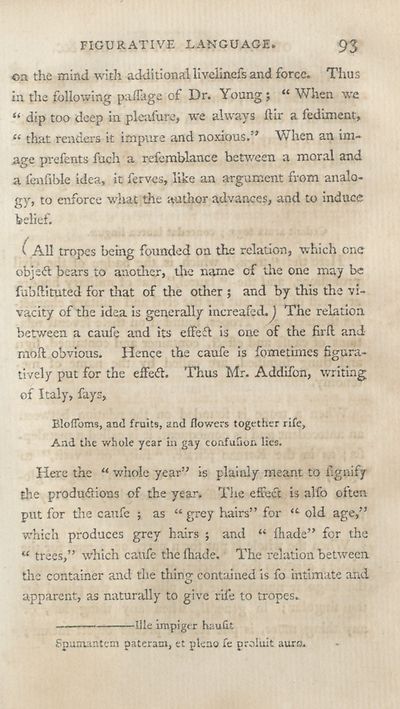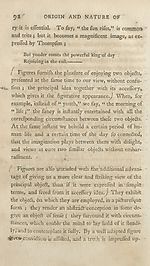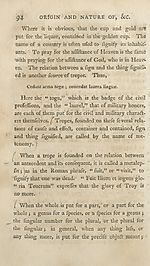Download files
Complete book:
Individual page:
Thumbnail gallery: Grid view | List view

FIGURATIVE LANGUAGE. 95
on the mind with additional livelinefs and force. Thus
in the following paflage of Dr. Young ; “ When we
“ dip too deep in plealure, we always ftir a fediment,
“ that renders it impure and noxious.” When an im¬
age prefents fuch a refemblance between a moral and
a fenfibk idea, it ferves, like an argument from analo¬
gy, to enforce what the author advances, and to induce
belief.
All tropes being founded on the relation, which one
objeft bears to another, the name of the one may be
fabtlituted for that of the other ; and by this the vi¬
vacity of the idea is generally increafed. 1 The relation
between a caufe and its effeff is one of the firft and
moil obvious. Hence the caufe is fometimes figura¬
tively put for the effett. Thus Mr. Addifon, writing
of Italy, fays,
Bloffoms, and fruits, and flowers together rife.
And the whole year in gay confufioi. lies.
Here the “ whole year” is plainly meant to fignify
the produ&ions of the year. The effect is alfo often
put for the caufe ; as “ grey hairs” for “ old age,”
which produces grey hairs ; and “ fhade” for the
“ trees,” which caufe the lhade. The relation between
the container and the thing contained is fo intimate and
apparent, as naturally to give rife to tropes.
Die impiger haufit
Spumantem pateram, et pleno fe proluit auxo.
on the mind with additional livelinefs and force. Thus
in the following paflage of Dr. Young ; “ When we
“ dip too deep in plealure, we always ftir a fediment,
“ that renders it impure and noxious.” When an im¬
age prefents fuch a refemblance between a moral and
a fenfibk idea, it ferves, like an argument from analo¬
gy, to enforce what the author advances, and to induce
belief.
All tropes being founded on the relation, which one
objeft bears to another, the name of the one may be
fabtlituted for that of the other ; and by this the vi¬
vacity of the idea is generally increafed. 1 The relation
between a caufe and its effeff is one of the firft and
moil obvious. Hence the caufe is fometimes figura¬
tively put for the effett. Thus Mr. Addifon, writing
of Italy, fays,
Bloffoms, and fruits, and flowers together rife.
And the whole year in gay confufioi. lies.
Here the “ whole year” is plainly meant to fignify
the produ&ions of the year. The effect is alfo often
put for the caufe ; as “ grey hairs” for “ old age,”
which produces grey hairs ; and “ fhade” for the
“ trees,” which caufe the lhade. The relation between
the container and the thing contained is fo intimate and
apparent, as naturally to give rife to tropes.
Die impiger haufit
Spumantem pateram, et pleno fe proluit auxo.
Set display mode to:
![]() Universal Viewer |
Universal Viewer | ![]() Mirador |
Large image | Transcription
Mirador |
Large image | Transcription
| Antiquarian books of Scotland > Languages & literature > Abridgement of lectures on rhetoric > (109) |
|---|
| Permanent URL | https://digital.nls.uk/135467762 |
|---|
| Description | Thousands of printed books from the Antiquarian Books of Scotland collection which dates from 1641 to the 1980s. The collection consists of 14,800 books which were published in Scotland or have a Scottish connection, e.g. through the author, printer or owner. Subjects covered include sport, education, diseases, adventure, occupations, Jacobites, politics and religion. Among the 29 languages represented are English, Gaelic, Italian, French, Russian and Swedish. |
|---|

